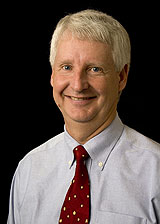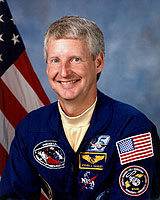July 31, 2006
An astronomer in space: Alumnus Steven Hawley reflects on his career at NASA
By Tim Stephens
Every astronaut is impressed by the view of Earth from space. For NASA astronaut Steven Hawley, though, the view in the other direction was just as impressive--an endless expanse of stars shining clear and bright, without the twinkling distortions of the atmosphere or the dimming effects of light pollution.
| View video clip from the interview with Steven Hawley |

Steven Hawley earned his Ph.D. in astronomy and astrophysics from UCSC in 1977.
Photo: Jim MacKenzie |

NASA began recruiting scientists and engineers into the astronaut program when Hawley was a graduate student at UCSC.
Photo: NASA |
"As an astronomer, I always liked to look at the stars, but most of the other astronauts liked to look at Earth, so there was always a bit of a battle over which way we were going to point the shuttle," said Hawley, who flew on five space shuttle missions and now serves as director of astromaterials research and exploration science at NASA's Johnson Space Center.
Hawley, who grew up in Salina, Kansas, got interested in astronomy at an early age. He studied physics and astronomy at the University of Kansas and earned his Ph.D. in astronomy and astrophysics from UCSC in 1977. He returned to UCSC in June to give the keynote address at the graduate student commencement ceremony.
"There was never any doubt that I wanted to be an astronomer, and that's what I set myself up for," Hawley said. "UC Santa Cruz was fairly young when I was looking at graduate schools, but it already had a world-class astronomy department. By incorporating the Lick Observatory astronomers, it immediately became one of the top schools in the country for astronomy, and I was lucky enough to get in."
His career as an astronaut was unplanned and unexpected, but when the opportunity came along, Hawley jumped on it.
"You don't know what opportunities will be out there, so you need to prepare yourself as best you can, be alert, and then jump on them when they become available and hope for the best," he said.
NASA had just begun to recruit scientists and engineers into the astronaut program when Hawley was completing his graduate studies at UCSC. He sent in an application, but never really expected to get in. He was working as a postdoctoral researcher at the Cerro Tololo Inter-American Observatory in Chile when he heard from NASA that he'd been accepted.
"The elation of being picked to be an astronaut at NASA quickly changed to apprehension. I had no certainty that it was something I could do, and I knew it would be very challenging," Hawley said.
At first, he tried to stay involved in astronomy, conducting research and publishing a few papers. "But it became clear that if I were going to excel at astronaut training, I needed to devote 100 percent of my time to it," he said.
As it turned out, he flew on several space shuttle missions that were enormously important to the field of astronomy. In 1990, he was part of the crew aboard the shuttle Discovery that deployed the Hubble Space Telescope. He returned to the Hubble on a maintenance mission in 1997, completing major upgrades and repairs to the orbiting telescope. And on his last space flight, in 1999, he helped deploy the Chandra X-ray Observatory.
"For me, as an astronomer, to be able to participate in those kinds of missions was something really special," Hawley said. "To be associated with Hubble and Chandra--you couldn't have written a script that was any better than that."
At times, Hawley's expertise as both a scientist and an astronaut enabled him to bridge the gap between the NASA engineering and operations group and the scientists involved in projects carried on space shuttle missions. If the needs of a particular project conflicted with the demands of shuttle operations, he could understand the concerns on both sides and help them reach a solution.
"Sometimes, somebody who is recognized as having expertise in both areas can step in and explain why something is really important and why we've got to figure out how to make it work. So I was kind of a broker between the two camps," he said.
In his current position, Hawley directs scientific research in planetary and space science at Johnson Space Center. His organization maintains a remarkable collection of extraterrestrial specimens that began with the samples brought back from the moon by the Apollo Program. That collection has since evolved to include about six important collections, including moon rocks, meteorites, and interstellar dust particles. Hawley oversees research on these specimens by NASA scientists and the broader research community. He also oversees research on scientific issues important to human exploration of space, such as the risks to spacecraft from orbital debris and meteorites.
The most recent additions to NASA's astromaterials collections are the samples from the Genesis mission, which sampled the solar wind, and the Stardust mission, which collected comet samples.
"We also have the spacecraft themselves," Hawley said. "Stardust, in particular, is interesting because it came back at the highest velocity of any manmade object, having been out to the comets and out to Jupiter. So we now have something the engineers can look at to see how the thermal protection worked at those high velocities on reentry."
Hawley still keeps track of important findings from the Hubble Space Telescope and the Chandra X-ray Observatory, and he takes pride in his role in those projects. "I like being able to tell people what Hubble's been doing lately and talk about some of the remarkable discoveries that Hubble has made," he said.
In his commencement address in June, Hawley emphasized three principles that have been important to his success: accountability, discipline, and passion. Of those, he said, passion may be the most important.
"A lot of people ask me what they need to do to become an astronaut and if they should take astronomy. And I ask them, 'Well, do you like astronomy?' Because if you don't like it you won't be very good at it," Hawley said. "I've been lucky enough to do something I really enjoy."